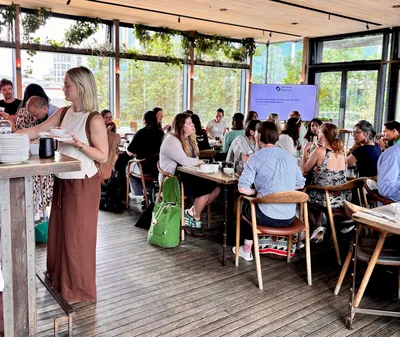How charities can build genuine connections with Gen Z supporters
Yesterday morning, we gathered charity leaders at The Lighterman in King's Cross to tackle a challenge that keeps coming up in our conversations: how to genuinely engage Gen Z supporters.
Everyone knows they need to engage younger audiences, but somehow it keeps slipping down the priority list – only 28% of charities prioritise growing a young supporter base (Charity Digital Skills Report 2025).

Why we need young people in the room
I loved that Zoe Amar shared insights from chatting with her 15-year-old son about her presentation. His perspective was both fascinating and sobering. When asked how he'd decide which charity to donate to, he said: "What is the most pressing issue in the world – for example, a chariy that helps when there is another war."
Not if there's another war. When.
It's a stark reminder of how this generation sees the world and what they expect charities to respond to. He also, quite rightly, asked why he wasn't invited to the event to give his feedback directly. We're talking about engaging young people, but how often are we actually talking with them?
The gap between intention and reception
Cato Hunt from Space Doctors explored semiotics – the idea that our intended meaning doesn't always match what's actually received. We might think we're being relevant and authentic, but are we really landing that way with Gen Z?
Cato's three principles for connecting with young audiences were brilliantly simple:
- Be distinctive
- Be relevant
- Be part of their world
Not revolutionary concepts, but ones that require us to step outside our charity bubble and genuinely understand how we come across to the people we're trying to reach.

Making support not feel like support
Devia Gurjar from NSPCC struck me with her insight about making "advice and support not feel like advice and support." There's something profound about completely reimagining how we deliver what young people need, meeting them where they are rather than where we think they should be.
She shared how they tackled Childline's "consideration problem"; most young people knew about the service but didn't think it was relevant to them, especially boys. Through authentic partnerships with influencers and creative campaigns like "Leng or Liar," they transformed that perception into genuine engagement.
The trust gap we need to bridge
Josephine Hansom highlighted a crucial disconnect: while 55% of marketers think their campaigns resonate with Gen Z, only 42% of Gen Z agree. That's not a small gap – it's a chasm that could be undermining everything we think we're doing right.
Her message that "it's OK to be emotional" felt particularly important. In a world where trust is fragile and authenticity is everything, perhaps we need to stop being so polished and start being more human in how we connect.
The skills gap and playing the long game
With 76% of charities now using AI, Zoe revealed that 36% say their CEOs have poor AI skills, while 44% say their boards do. This leadership disconnect could be holding back the digital innovation needed to reach younger audiences effectively.
But the biggest takeaway? This is about playing the long game. Young people are deeply committed to causes they care about; they're just engaging differently through social media advocacy, volunteering, and sharing campaigns. They're building relationships with charities long before they have the financial means to become regular donors.
They have high expectations for transparency and impact, but when we get it right, they're incredibly committed supporters who will advocate, volunteer, and share our messages in ways that can amplify our reach.
If they care about you, they will stick with you.
The question that matters
Several attendees made the comparison to legacy giving – we invest in that long-term relationship-building because we know the returns come later. Why aren't we applying the same thinking to younger supporters?
The question isn't whether we should engage younger supporters, it's whether we're brave enough to listen to what they're telling us about how we come across.
Are you asking young people directly how your charity lands with them? Because if yesterday taught us anything, it's that assumptions are dangerous, and the people we're trying to reach might just have the answers we need.
Thank you to everyone who joined us from organisations including British Red Cross, Tearfund, Cancer Research UK, Action for Children, and many more. And huge thanks to our brilliant speakers and Phil McMinn for chairing the panel discussion.

Keen to explore how to engage with younger audiences but not sure where to start?
Amina Iqbal Director of Client Services
Get in touch


